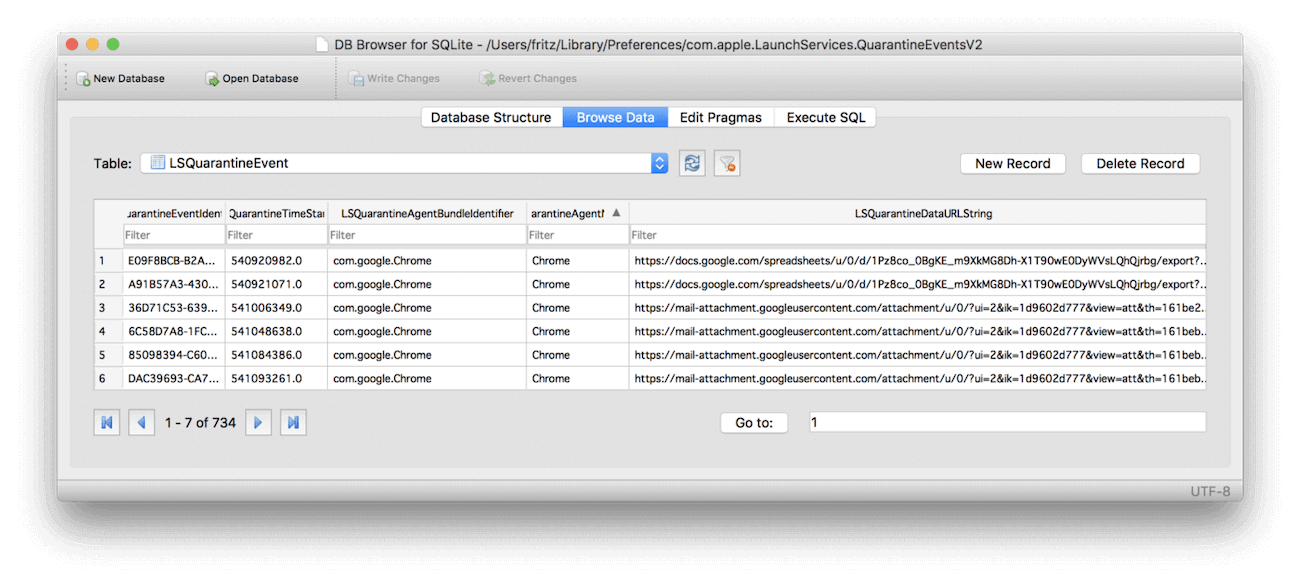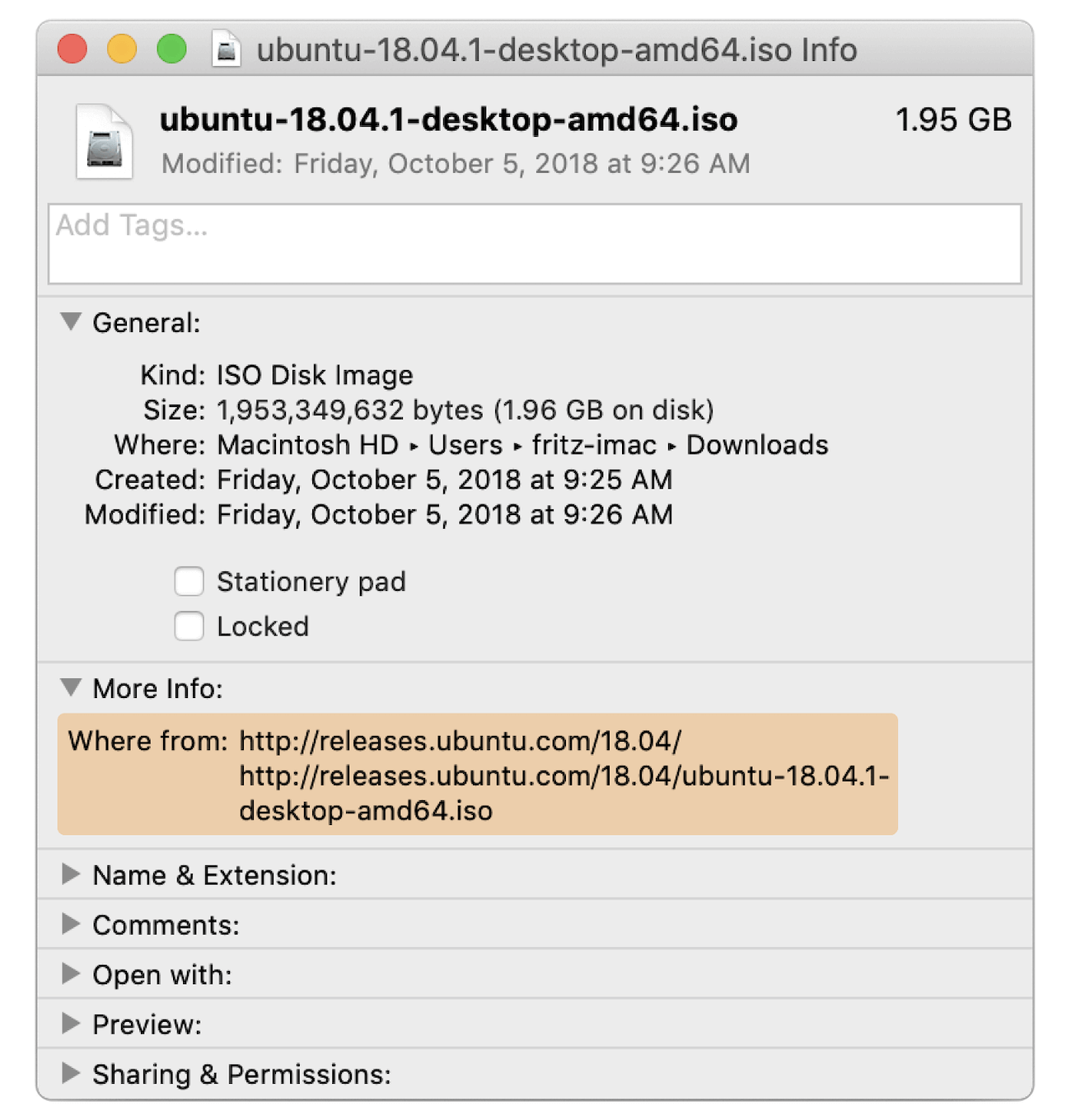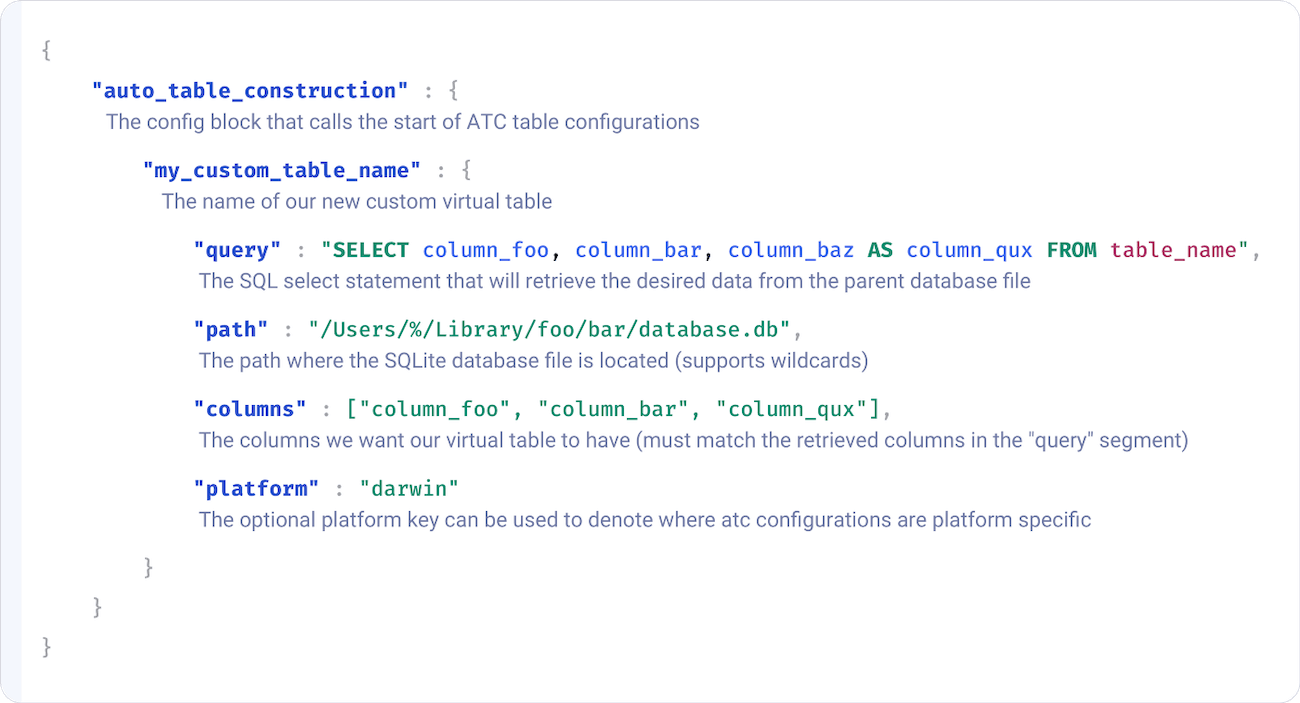In this tutorial, we’ll break down how you can use osquery’s ATC feature to expand osquery’s data collection capabilities.
As an example, we will look into how to tap into macOS' quarantine events database to search files to help locate malware a user may have downloaded from a web browser. But before we dig into the details, let’s start at the beginning.
What is an ATC table?
ATC (automatic table construction) is a method which can expose the contents of local SQLite database files as an osquery virtual table.
ATC was added to osquery by Mitchell Grenier (obelisk) in response to a number of virtual table pull requests which all functioned by parsing SQLite databases. Rather than approving each table as a separate pull request, Mitchell took the opportunity to add a native SQLite parsing method to osquery, which would allow adding any number of new virtual tables on a customizable basis.
Why is parsing SQLite DBs useful?
Many applications use SQLite databases as a storage method for application data, including things like:
Google Chrome Browser History
1Password Vault Sync Configuration
Skype Call History
iMessage Chat History
macOS Quarantine Events (System-wide Download History)
As these examples illustrate, while application databases can provide tremendous utility, they also represent a potential concern for user privacy (a core tenet of osquery’s security philosophy). There are times, however, where the introspection of databases can be invaluable to an incident response team in their forensics gathering (eg. the aforementioned Quarantine Events database).
While you may be concerned by the privacy implications of reading databases containing PII, you can take some solace in the fact that ATC tables must be declared at a configuration level in osquery and are not as simple as:
SELECT * FROM atc_table WHERE path = '/foo/bar.db'
Let’s examine a real life scenario in which ATC tables could be utilized to expand the data collection capabilities of osquery.
Searching the macOS download history using ATC:
“My computer was infected with malware, but don’t worry I cleaned it up.”
There are few things more frustrating to an incident response team than the needless deletion of evidentiary findings. Discovering the active presence of malware on a device is of the highest concern. However, it is equally vital to know about the past-presence of malware and its respective source of origin (eg. an installer download link sent via email).
Yet, combing through various download history files is no one’s idea of fun, and not all applications keep a record.
You might be surprised to learn, however, that if you are using an Apple computer, a record of every file you’ve ever downloaded exists on your device. No matter whether it was downloaded in Safari, Chrome, Mail.app, AirDrop, or any other third-party application, it’s right there all in one convenient location:
~/Library/Preferences/com.apple.LaunchServices.QuarantineEventsV2

Files downloaded from external sources are embedded with metadata exposing their source of origin and the timestamp of when they were downloaded. The historical record of this embedded metadata is subsequently kept in the aforementioned database “QuarantineEvents.”
You can inspect this metadata on an individual file within Finder by right-clicking on an item in your Downloads folder and clicking Get Info:

What’s more, this metadata, including the Where From, is cached by macOS Spotlight and can be queried against using osquery, as in the following example:
SELECT
f.path,
f.size,
datetime(f.btime, 'unixepoch') AS file_created
FROM file f
JOIN mdfind ON mdfind.path = f.path
AND mdfind.query = "kMDItemWhereFroms = '*ubuntu.com*'"
path = /Users/fritz-imac/Downloads/ubuntu-18.04.1-desktop-amd64.iso
size = 1953349632
file_created = 2018-10-05 13:25:09
Conceivably, we could get a list of all downloaded files on a device by querying the mdfind table for any file where kMDItemWhereFroms is not blank. However, this would only expose files which were still present on disk.
The real beauty of QuarantineEvents is the ability to introspect the historical record of downloads. Unfortunately, there isn’t a quarantine_events table in vanilla osquery … but using a custom ATC configuration, there can be!
Quarantine events ATC table configuration
The basic anatomy of the config block is pretty self explanatory, but we will still break it down for the sake of being thorough:

So what does that look like in practice?
Using the example of QuarantineEvents, let’s examine a sample osquery configuration file which you can try at home:
{
"auto_table_construction" : {
"quarantine_items" : {
"query" : "SELECT LSQuarantineEventIdentifier as id, LSQuarantineAgentName as agent_name, LSQuarantineAgentBundleIdentifier as agent_bundle_identifier, LSQuarantineTypeNumber as type, LSQuarantineDataURLString as data_url,LSQuarantineOriginURLString as origin_url, LSQuarantineSenderName as sender_name, LSQuarantineSenderAddress as sender_address, LSQuarantineTimeStamp as timestamp from LSQuarantineEvent",
"path" : "/Users/%/Library/Preferences/com.apple.LaunchServices.QuarantineEventsV2",
"columns" : ["id", "type", "agent_name", "agent_bundle_identifier", "timestamp", "sender_name", "sender_address", "origin_url", "data_url"]
}
}
}
Passing the config file to test in Osqueryi
Because ATC tables are generated based on a configuration file, we need to pass that file to osqueryi. We can run the following command to pass a custom config and return the build process and any errors that might occur:
sudo /usr/local/bin/osqueryi --verbose --config_path**
/Users/fritz/Downloads/ATC-quarantine_items.json
Once the config file has been passed, you should be able to query the table as if it were any other virtual table in osquery (including support for tab completion). So in the case of our earlier example quarantine_items.
SELECT
agent_name,
origin_url,
data_url
FROM quarantine_items
WHERE data_url LIKE '%.dmg'
LIMIT 1;
agent_name = Chrome
origin_url = https://www.hopperapp.com/download.html?
data_url = https://d2ap6ypl1xbe4k.cloudfront.net/Hopper-4.3.16-demo.dmg
It’s as simple as that! You’ve just extended the data source capabilities of your osquery installation! Let’s go over some of the subsequent things you might want to do.
Closing the loop: finding downloaded files on disk
SELECT mdfind.path,
ROUND((f.size * 10e-7),2) AS size_megabytes,
datetime(f.btime, 'unixepoch') AS file_created,
MAX(CASE
WHEN md.key = 'kMDItemWhereFroms'
THEN md.value
END) AS download_source_csv
FROM mdfind
LEFT JOIN mdls md ON mdfind.path = md.path
JOIN file f ON f.path = mdfind.path
AND mdfind.query = "kMDItemWhereFroms == '*google.com*'c"
GROUP BY f.path;
Using the mdfind table, we can procedurally return the paths of any file downloaded from the web, still on disk, by cross referencing three tables:
mdfind(finding the path of files that have akMDItemWhereFroms)extended_attributes(finding the quarantineeventid)quarantine_items(finding the download metadata)
The below query would return the last three items which you downloaded:
SELECT
mdfind.path,
f.size,
datetime(f.btime, 'unixepoch') AS file_created,
ea.value AS quarantine_event_id,
(SELECT data_url from quarantine_items WHERE id = ea.value) AS
data_url
FROM extended_attributes ea
JOIN mdfind ON mdfind.path = ea.path
JOIN file f ON f.path = mdfind.path
AND mdfind.query = "kMDItemWhereFroms = 'http*'"
AND ea.key = 'quarantine_event_id'
AND data_url != ''
GROUP BY ea.value
ORDER BY f.btime DESC
LIMIT 3;
Caveats to ATC functionality
Properly formatting the ATC configuration blocks
It’s important to note that due to the JSON formatting of the ATC configuration block, you must adhere to certain idiosyncratic patterns. For example, you cannot include line breaks in the content of your query section. Doing so will produce the following error state:
E1207 09:36:10.862380 249753088 config.cpp:869] updateSource failed to parse config, of source: /Users/fritz/Downloads/quarantine-events.json and content: {...ATC query...}
I1207 09:36:10.862442 249753088 init.cpp:618] Error reading config: Error parsing the config JSON
Likewise, if you mistakenly declare a column that does not exist or select from a table that does not exist, you will encounter a rather vague error:
I1207 09:40:43.539501 282201600 virtual_sqlite_table.cpp:111] ATC table: Could not prepare database at path: "/Users/fritz/Library/Preferences/com.apple.LaunchServices.QuarantineEventsV2"
W1207 09:40:43.540674 282201600 auto_constructed_tables.cpp:47] ATC Table: Error Code: 1 Could not generate data: Could not prepare database for path /Users/%/Library/Preferences/com.apple.LaunchServices.QuarantineEventsV2
Double checking that your query works in a terminal first is critical to ensuring your configuration block is going to be interpreted as you expect:
sudo sqlite3 -header ~/Library/Preferences/com.apple.LaunchServices.QuarantineEventsV2
"SELECT
LSQuarantineEventIdentifier as id,
LSQuarantineAgentName as agent_name,
LSQuarantineAgentBundleIdentifier as agent_bundle_identifier,
LSQuarantineTypeNumber as type,
LSQuarantineDataURLString as data_url,
LSQuarantineOriginURLString as origin_url,
LSQuarantineSenderName as sender_name,
LSQuarantineSenderAddress as sender_address,
LSQuarantineTimeStamp as timestamp
FROM LSQuarantineEvent;"
id|agent_name|agent_bundle_identifier|type|data_url|origin_url|sender_name|sender_address|timestamp
2B5CD5A1-C85C-4400-BEC4-469FF01B5CFC|sharingd||6|||Fritz Ifert-Miller||660060258.698253
3863CBCC-3ED5-4000-B127-9D39D5AE718C|sharingd||6|||Fritz Ifert-Miller||660060153.611904
...
Knowing our query actually returns data from the database when queried directly is invaluable!
Windows path nuances
Although ATC works with all of the platforms, you must be mindful of differences in path formatting across operating systems. Unix based systems use the /foo/bar/ convention. Paths defined in your Windows ATC config will need to be formatted with double \ slashes. We use \\ to properly escape the \ character in SQLite. For example:
\\Users\\%\\AppData\\Local\\Google\\Chrome\\User Data\\%\\History
No data-typing
ATC tables do not preserve their respective datatypes when they are parsed and imported by osquery. As a result, all data is stored in the string format and must be CONVERT‘ed or CAST back to the desired datatype (eg. int, float, boolean, etc.) if you would like to interact with it as a specific type.
Sample Osquery ATC configurations:
I’ve included a few sample configurations here, which you can play with in your own osquery instance if you are so inclined.
Google Chrome login keychain
Returns a list of all website logins performed within Google Chrome:
{
"auto_table_construction" : {
"chrome_login_keychain" : {
"query" : "SELECT origin_url, action_url, username_value, password_element FROM logins",
"path" : "/Users/%/Library/Application Support/Google/Chrome/Default/Login Data",
"columns" : ["origin_url", "action_url", "username_value", "password_element"],
"platform" : "darwin"
}
}
}
Google Chrome browser history
Returns the browser history stored by Google Chrome.
If you would like to try all of the mentioned tables for yourself and merely download the configuration file you can find it at the following Gist:
{
"auto_table_construction" : {
"quarantine_items" : {
"query" : "SELECT LSQuarantineEventIdentifier as id, LSQuarantineAgentName as agent_name, LSQuarantineAgentBundleIdentifier as agent_bundle_identifier, LSQuarantineTypeNumber as type, LSQuarantineDataURLString as data_url,LSQuarantineOriginURLString as origin_url, LSQuarantineSenderName as sender_name, LSQuarantineSenderAddress as sender_address, LSQuarantineTimeStamp as timestamp from LSQuarantineEvent",
"path" : "/Users/%/Library/Preferences/com.apple.LaunchServices.QuarantineEventsV2",
"columns" : ["id", "type", "agent_name", "agent_bundle_identifier", "timestamp", "sender_name", "sender_address", "origin_url", "data_url"]
},
"chrome_browser_history" : {
"query" : "SELECT urls.id id, urls.url url, urls.title title, urls.visit_count visit_count, urls.typed_count typed_count, urls.last_visit_time last_visit_time, urls.hidden hidden, visits.visit_time visit_time, visits.from_visit from_visit, visits.visit_duration visit_duration, visits.transition transition, visit_source.source source FROM urls JOIN visits ON urls.id = visits.url LEFT JOIN visit_source ON visits.id = visit_source.id",
"path" : "/Users/%/Library/Application Support/Google/Chrome/%/History",
"columns" : ["path", "id", "url", "title", "visit_count", "typed_count", "last_visit_time", "hidden", "visit_time", "visit_duration", "source"],
"platform" : "darwin"
},
"chrome_login_keychain" : {
"query" : "SELECT origin_url, action_url, username_value, password_element FROM logins",
"path" : "/Users/%/Library/Application Support/Google/Chrome/Default/Login Data",
"columns" : ["origin_url", "action_url", "username_value", "password_element"],
"platform" : "darwin"
}
}
}
How does 1Password Extended Access Management use ATC?
As we’ve seen in this article, ATC is an incredibly powerful feature of osquery that can be used to dramatically expand the scope of its data collection. To ensure the integrity of privacy promises, we maintain control over which ATC tables are deployed to the agent and use the feature to power our flagship features like inventory and checks.
1Password® Extended Access Management’s Device Trust solution uses ATC to enable the following use cases:
To locate two-factor backup codes downloaded via Chrome and Firefox Windows and Linux Devices
To enumerate macOS’ permissions database in inventory
To enumerate Windows Update history
To verify specific settings in apps that use SQLite DB (like the 1Password enterprise password manager)
For instance, 1Password Extended Access Management can show admins a straightforward list of the TCC (Transparency, Consent, and Control) permissions on end-users' devices, allowing oversight into what access different apps have to data on the endpoint.
Additional reading
If you are interested in some of the other concepts presented in this post I would strongly encourage you to keep your eyes on the 1Password blog. This is just one blog in a series of published and upcoming posts on all things osquery.
If you’re eager to try out this functionality yourself, reach out for a demo!

 by Fritz Ifert-Miller on
by Fritz Ifert-Miller on


